
TEMPORARY CLERGY
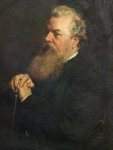 Although
Bryan King remained in post until 1863, he was exhausted by the
Ritualism Riots, and took a year's leave of absence. With his consent,
in July 1860 Bishop Tait appointed Septimus
Cox Holmes Hansard [painting right by Lowes Cato Dickinson, c1880-90] as priest-in-charge for a year. From the family that produced the
parliamentary reports, he was a schoolfriend at Rugby of Thomas Hughes,
who based the Tom
Brown's Schooldays
character of Holmes the praepostor, 'one of the best boys in the
school', on him. For a time, when Hughes' daughter died in 1858, it was
rumoured that Hansard would complete the book, but this was not to be.
He had been curate of St Mary Bryanston Square for twelve years, and
was recommended to Tait as 'caretaker' for St George-in-the-East by
Dean Stanley and Hughes, who said he was a
man without equal for dealing with the roughest part of a London
population. As
a high churchman he was in some sympathy with King, but was also a
Christian Socialist - a friend of F.D. Maurice, and an active vistor
during the cholera epidemics. For the following year he was Kingsley's
assistant in Eversley, Hampshire. For 31 years until his death in 1895
he
was Rector of St Matthew Bethnal Green, where
he introduced a daily eucharist, and campaigned for a free library and
Sunday opening of museums (he was a founder of the East London Museum
there). Stewart Headlam, who founded the Guild of St Matthew, was his curate from 1873-78. Although
generous and much-admired, Hansard was autocratic and lived in some style,
so like King aroused the hostility of church and school officials.
Although
Bryan King remained in post until 1863, he was exhausted by the
Ritualism Riots, and took a year's leave of absence. With his consent,
in July 1860 Bishop Tait appointed Septimus
Cox Holmes Hansard [painting right by Lowes Cato Dickinson, c1880-90] as priest-in-charge for a year. From the family that produced the
parliamentary reports, he was a schoolfriend at Rugby of Thomas Hughes,
who based the Tom
Brown's Schooldays
character of Holmes the praepostor, 'one of the best boys in the
school', on him. For a time, when Hughes' daughter died in 1858, it was
rumoured that Hansard would complete the book, but this was not to be.
He had been curate of St Mary Bryanston Square for twelve years, and
was recommended to Tait as 'caretaker' for St George-in-the-East by
Dean Stanley and Hughes, who said he was a
man without equal for dealing with the roughest part of a London
population. As
a high churchman he was in some sympathy with King, but was also a
Christian Socialist - a friend of F.D. Maurice, and an active vistor
during the cholera epidemics. For the following year he was Kingsley's
assistant in Eversley, Hampshire. For 31 years until his death in 1895
he
was Rector of St Matthew Bethnal Green, where
he introduced a daily eucharist, and campaigned for a free library and
Sunday opening of museums (he was a founder of the East London Museum
there). Stewart Headlam, who founded the Guild of St Matthew, was his curate from 1873-78. Although
generous and much-admired, Hansard was autocratic and lived in some style,
so like King aroused the hostility of church and school officials. | RECOLLECTIONS OF THE CRIMEA - ON BEHALF OF THE WEBBER BOW RAGGED SCHOOLS On Friday evening, Feb. 11th, Dr. Cay, of the Coldstream Guards, the companion of the lamented Capt. Hedley Vicars, gave his "Recollections of the Crimea" at the Horns Assembly Rooms, Kennington, to one of the largest and most influential audiences ever gathered together in that locality. The Right Hon. the Earl of Shaftesbury presided. Previous to the lecture the band of the Coldstream Guards, under the leadership of Mr Godfrey, performed a selection of some brilliant gems of music. The effect on entering the room was most picturesque—a magnificent illuminated view of the storming of Sebastopol, with the capture of the Malakoff, seemed to transport one to the scene of Dr. Cay's recollections. This was heightened by the presence of the band of the Coldstream Guards in their handsome uniform, standing in the foreground alongside the Crimean tent. The Rev. Alfred Cay is the director of the course of lectures, on behalf of these schools. Dr. Cay gave a highly interesting narrative of his personal Recollections of the Crimea, in which he drew graphic sketches of the dangers and hardships of our army; the account he gave of his having bur army been seized upon as a spy by a sentinel of one of the English regiments of the line caused great amusement. The second part of the lecture was devoted to reminiscences of Captain Hedley Vicars, with whom Dr Cay had been acquainted for some eleven or twelve years. A most striking incident in the last dying hours of Capt. Vicars was given. The lecturer said:—"When my beloved friend was bleeding to death from the severing of the artery, every one was begging for a handkerchief or a bandage, but none could be found, and the fatal consequence was that he bled to death; strange and mysterious to say, as I searched the garments of my lamented brother for some keepsakes to send home, the first thing I discovered was his own handkerchief in his coat pocket. Had this been bound round his arm, Hedley Vicars might have been now alive and speaking for himself. God, in his providence, however, willed it otherwise. He required his presence in that better world above." A vote of thanks was enthusiastically passed to the lecturer, and also to the noble chairman who pressed home the claims of the Ragged School movement on every Christian present, and placed before them the example of Captain Vicars, who for years took a deep personal interest in this and every other good work. |
| I have no clerical assistance, having to undertake all the duties in church, which are heavy, together with the visitation of the sick and destitute. The amount of ignorance, and poverty, and iniquity, is something appalling. You may form some idea of it when I state that the parish under my charge takes in 'Ratcliff Highway', and all the courts and dens of sin adjoining. I feel, in fact, at times utterly borne down by the weight of my responsibility, and the almost hopeless task of grappling alone with such a world of darkness and sin. I do not believe there is another parish in London that stands more in need of a Reader. |
The parish of St.
George-in-the-East, which during the last twelve months has subsided
into peace and harmony under the charge of the Rev. Alfred Cay, seems
likely again to appear prominently before the public on the occasion of
the leave of absence of the Rector expiring at the end of the present
month. The Rev. Bryan King does not intend to return himself to the
parish, but he has intimated his intention of appointing a Curate to
attend to the ministrations in the church, which will have the effect
of depriving the parish of the services of the Rev. A. Cay who, by
appointment of the Bishop of London, has for about a year discharged
ministerial duties in St. George's.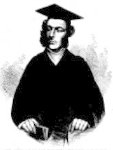 When the Rev. Alfred Cay, of whom we this week engrave a portrait [left],
entered upon the charge he had no easy task before him. Most of the
parishioners had entirely left the church and had united themselves
with other churches. A church rate had not been raised; being a parish
church, there are no rents from the parish; the church itself was in
the most deplorable state; the churchwardens were in debt for all
expenses; in fact Mr. Cay might have taken the words of Jacob to
himself, "All things are against me". The result, however, shows
how much can be done by being at unity with the people. The creditable
manner in which the churchwardens and parishioners have come forward to
support their parish church and present minister will be an enduring
monument in their faith. Though by no means a wealthy parish, as much
has been done by the people of St. George's towards restoring the
church, supporting its work, and in ministering to the poor as in many
much more favoured places. As a proof of approbation, the following
divines have come forward and on various occasions occupied the pulpit:
[list of names].
The special services on Tuesday evening have been attended with great
success. From 600 to 1400 persons frequently attend these, and on
Tuesday evening last week the Bishop of London preached, on which
occasion about thirty clergymen of the neighbouring parishes, all
habited in their academical robes, assembled in the church to receive
his Lordship, and there were also present the churchwardens, sidesmen
and several members of the vestry. The church was crowded in every
part, and the congregation was composed of respectable tradesmen and
their families, and numbered few of the extraordinary class who
formerly used to conduct themselves in so very discreditable a manner
during the progress of the service. When the Rev. Alfred Cay, of whom we this week engrave a portrait [left],
entered upon the charge he had no easy task before him. Most of the
parishioners had entirely left the church and had united themselves
with other churches. A church rate had not been raised; being a parish
church, there are no rents from the parish; the church itself was in
the most deplorable state; the churchwardens were in debt for all
expenses; in fact Mr. Cay might have taken the words of Jacob to
himself, "All things are against me". The result, however, shows
how much can be done by being at unity with the people. The creditable
manner in which the churchwardens and parishioners have come forward to
support their parish church and present minister will be an enduring
monument in their faith. Though by no means a wealthy parish, as much
has been done by the people of St. George's towards restoring the
church, supporting its work, and in ministering to the poor as in many
much more favoured places. As a proof of approbation, the following
divines have come forward and on various occasions occupied the pulpit:
[list of names].
The special services on Tuesday evening have been attended with great
success. From 600 to 1400 persons frequently attend these, and on
Tuesday evening last week the Bishop of London preached, on which
occasion about thirty clergymen of the neighbouring parishes, all
habited in their academical robes, assembled in the church to receive
his Lordship, and there were also present the churchwardens, sidesmen
and several members of the vestry. The church was crowded in every
part, and the congregation was composed of respectable tradesmen and
their families, and numbered few of the extraordinary class who
formerly used to conduct themselves in so very discreditable a manner
during the progress of the service.At a meeting of the vestry, held after the notification of Mr. Cay's approaching departure was made, it was resolved that a memorial should be presented to that rev. gentleman in acknowledgment of the satisfactory manner in which he had conducted the affairs of the church, and that a public meeting of the inhabitants of the parish should be held with a view of presenting Mr. Cay with a suitable testimonial from the people. This meeting was accordingly held under the presidency of Mr. Churchwarden Thompson [William John Thompson was landlord of the Crown & Dolphin, and churchwarden from 1858-59, though by no means a churchman], at which it was determined that such a testimonial should be given to Mr. Cay and a committee was appointed to receive contributions and carry out the object of the meeting. The several speakers on the occasion passed the highest encomiums on the conduct of Mr. Cay as minister in charge of the parish, especially on the manner in which he had conciliated the goodwill of the people and on the unwearied exertions he had made to relieve the wants of the poor during his ministry. The testimonial, we are glad to understand, is progressing in a most satisfactory manner. In further proof of the liberality of the people we may mention in addition to the testimonial which the parishioners have resolved to present to Mr. Cay they have presented to Mr. Thompson an elegant massive silver salver as a token of esteem and approbation for the persevering and judicious efforts he successfully made to restore the parish church to the freedom of Protestant worship. Fears are materialised, in consequence of Mr. Cay's departure and the advent of a Curate of Mr. King's influence, that troublous times for St. George's are at hand. Every one must deplore such an outcome. Much will depend on the character of the gentleman whom the Rector appoints, and we sincerely hope that such a choice will be made as may not again disturb the peace of the parish. No doubt the Bishop of London will use his influence to do all that can possibly done to ensure this result. His selection of Mr. Cay to take charge of St. George's-in-the-East shows how anxious his Lordship was to give to the people the services of a clergyman who would be acceptable to them and who would labour in a kindly spirit amongst them. |
John
Lockhart Ross
(1863-73)
Ross was distantly descended from
Vice-Admiral Sir John Lockhart Ross of Balnagowan (1721-90), who
introduced sheep farming to Scotland and thereby led the way to the
Clearances.
He was from
Oriel rather than Brasenose College
Oxford, and was ordained in 1835 to a curacy in Brignal, Yorkshire
before helping to establish the new theological college in Chichester
(and writing a piece on 'Thummim and Urim' in the Church of England
Magazine for 1838). He became Vicar of Fyfield & Idbury in
Oxfordshire, and from 1852-63 Vicar of Avebury in Wiltshire (later
writing about its druidical temples). As a college friend of
fellow-Scot Bishop Tait, and no doubt at Tait's
suggestion, he exchanged his
living at Avebury with Bryan King, who was finally able to leave the
parish. In the registers, until around 1870 he signed his name in
the old
style, with a long 's': Roſs.
|
A
note on ordination training About
twenty
theological colleges were established during the rest of the 19th
century. But for some time, until
clergy
became more 'professionalised' and conscious of their role (bolstered
by a range of organisations - see below, for example, on the Curates'
Clerical Society), an Oxford, Cambridge or Trinity
College Dublin
degree continued to be regarded as sufficient training to run a parish.
Bishop Blomfield (Bishop of London from 1828-56), though he was happy
to appoint men of diverse backgrounds to the East End even where their
theological positions were 'extreme', was reluctant in principle to
ordain Dublin graduates in his diocese (even those who were
highly-qualified), reasoning that Oxbridge
produced more than enough candidates - though plenty of Dublin men were
to
serve in the district churches of our parish (and see here for St Paul Dock Street), along with a number of
non-graduates ordained in Wales, and quite a few who were ordained, or
had served, overseas in various missionary situations and brought that
experience to their ministry here. Until around 1900, incumbents in all
our churches, and curates at the parish church, continued to be
Oxbridge graduates, without the benefit of further training. However,
since Brasenose College Oxford - who had been
the patrons of the parish - recruited heavily from the industrial towns
of the north west (Bryan King, for instance, was born in Liverpool),
many of them had a good inkling of what urban
ministry involved. Others came to know the area through the
college settlements in the East End, of which Toynbee Hall (1884) was
the first. |
In the 1840s Ross had seen that reform of cathedral finances could make his vision possible; Letters on Diocesan Theological Colleges, in connexion with proposed cathedral alterations (Parker 1849) included this summary of his position:
| Admirable as both our venerable and time-honoured universities are known and acknowledged to be, and have long been, still they are by no means fitted to form, by a course of training, young men who have for some years been otherwise there employed, and whose friendships and associations may in many cases disqualify them for entering on a more rigid course previous to ordination. |
While Ross was Rector, there were continuing problems with the Vestry. On 2 September 1872 he wrote to The Standard:
| The Vestry, who are principally Dissenters, have opposed all the Rector's efforts to resuscitate the parish and improve the social and religious interests of the people, and upwards of a year since they appointed as senior and acting churchwarden a Dissenter who, with his colleague, never previous to or since their appointment have attended Divine service, much less the Holy Communion, which is celebrated every Sunday in accordance with the time-honoured custom of this church....And it must be added with shame and regret that, though there has been, and can be, no possible charge of Ritualism on my part, such as was made the foundation of the former riots in this parish, I have received several communications acquainting me that several influential members of the parish have been using every means in their power to withdraw the usual respectable congregation and choir from renting pews (which is the practice here and in many other churches) or attending Divine service in the parish church....Such, sir, is a brief narration of the condition of St. George's-in-the-East, which, as an influential inhabitant stated a short time since, has been distinguished from all other London and other parishes for nearly a century by its normal and persistent opposition to all the rectors. The preponderance of Dissent is probably the cause of its past and present disorders and opposition to the Church. After so many years of labour, anxiety, and exile in this parish, it is sad and discouraging to have failed in, I now confess, my too ambitious and sanguine expectation of ameliorating and restoring this parish to an equal and respectable rank among the great parish or mother churches of London. As this is my first, so it will be also my last, public allusion to either the condition of St. George's or its recent proceedings, which have been only too partially referred to by your correspondent this morning. I feel, however, that I have spared no means or efforts in my power, during my lengthened incumbency, to discharge the solemn promises and vows which I took on my institution to this arduous and (as it unhappily turns out) thankless charge. |
| The church is entirely cleaned and painted; the pews altered in position and cut down, and varnished the original colour, oak; the old reading-desk is gone, and the pulpit, completely purified and beautified, has been transferred to the south side against the pillar near the robing vestry door; choir seats and clergy stalls have been erected; there are about ten choirmen and choirmaster, and as many trained boys, and the Sunday morning and evening services (not the afternoon) are choral, and perhaps as well, if not better, done than in many cathedrals. It has cost a good deal of funds, but more trouble and opposition, and the Architect and I have been left to pay the debt of £130! The Vestry are, as of old, up in arms, and last Easter appointed a Dissenter and manager of the large Wesleyan Chapel as Senior Warden, and his colleague is almost worse than himself. They presented me to the Bishop lately, but had no other charge than that I had not given them an account of the Sunday weekly offertories, which I stated were prepared annually at Avebury and St. George's, and were duly presented to the Bishop. Since their defeat (a deputation of five attended at London House) they have stopped the Church Bells on Sundays and week days, but as the Bishop is too busied to move, I take no notice of these proceedings beyond informing him that when he finds me another and more eligible position I am quite ready to resign; (the Vestry had requested the Bishop to remove me, which he begged to decline!); and so the Parish of St. George's and its affairs rest for the present, which I treat with perfect indifference and pursue steadily, as long as I am here, my own course. They are unable to find any charge against me or my doings, and I presume are sorry that they cannot charge me with Ritualism or ritualising tendencies. This is, as I have found shortly after my appointment, one of the worst parishes in England, and the people are most base, ungrateful, impracticable, and irreclaimable. I am sorry I can give you no better an account of your former flock, who seem to oppose all ecclesiastical authority. |
Harry
Jones (1873-1882)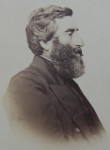 born in 1823, and the first Rector from Cambridge (St John's College) rather than
Oxford, came to the East End from the West End (St Luke Berwick
Street, Soho
1858-72 (where he abolished pew rents). He wrote extensively in
popular style on the
contrast between the two worlds - see his book of 1875 East and West London.
He was a Broad Churchman, in close touch with others of that ilk, and
was variously described as rich
and racy and bluff
and hearty. To
Charles Anderson, formerly a curate at St Mark Whitechapel who in 1874
became Vicar of St John Limehouse,
with a parsonage opposite the gasworks, he wrote that he hoped he would
diffuse more light and
less stink.
born in 1823, and the first Rector from Cambridge (St John's College) rather than
Oxford, came to the East End from the West End (St Luke Berwick
Street, Soho
1858-72 (where he abolished pew rents). He wrote extensively in
popular style on the
contrast between the two worlds - see his book of 1875 East and West London.
He was a Broad Churchman, in close touch with others of that ilk, and
was variously described as rich
and racy and bluff
and hearty. To
Charles Anderson, formerly a curate at St Mark Whitechapel who in 1874
became Vicar of St John Limehouse,
with a parsonage opposite the gasworks, he wrote that he hoped he would
diffuse more light and
less stink.
He
undoubtedly used his experience of East and West in his journalism
and
at the dinner table; but he protested that unlike others who came to
gawp at the East End, I
have not
dipped into it on philanthropical errands from the West....or hunted
within its border for curious literary materials ('Life and Work among
the East-London Poor' in Good Words
25 (1884) p50). See further Seth Koven Slumming: Sexual and Social
Politics in Victorian London
(Princeton 2004). He
invited many of the famous figures of the day to preach at the church.
His greatest achievement at St George-in-the-East was
the creation of St George's Gardens
as a much-needed green oasis - see
here for more details.
Because his activities and
interests were so
wide-ranging, both during his time here and afterwards, he deserves his
own page, which is here - including a sonnet by Bishop Walsham How.
Charles
Henry Turner (1882-97)
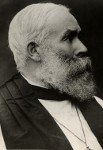 (from 1891 with St Matthew Pell
Street, and Rural Dean of Stepney for his last four years), son of the
barrister-treasurer of Guy's Hospital, was an
organised man – as befitted the Tenth Wrangler of Trinity
College
Cambridge, a former chaplain to the Bishop of London, and a Chaplain
to the Queen. He was well-provided with curates, and only occasionally
officiated at baptisms and weddings. He chaired the St George's (East)
Committee of the Charity Organisation Society, with other clergy from the local churches as fellow-members.
(from 1891 with St Matthew Pell
Street, and Rural Dean of Stepney for his last four years), son of the
barrister-treasurer of Guy's Hospital, was an
organised man – as befitted the Tenth Wrangler of Trinity
College
Cambridge, a former chaplain to the Bishop of London, and a Chaplain
to the Queen. He was well-provided with curates, and only occasionally
officiated at baptisms and weddings. He chaired the St George's (East)
Committee of the Charity Organisation Society, with other clergy from the local churches as fellow-members.  See here
for his 1892 involvement in a local executive addressing the plight of
dockworkers - he (together with C.S. Loch of the COS and Sir Charles
Fremantle) dissented from its recommendation for a public works job
creation programme, because of the likely cost to ratepayers). In 1888
he presided over the opening of Miss Steers'
Bridge of Hope Mission in Betts Street,
for which Harry Jones returned; she found Turner a good and supportive
source of practical advice. In 1897 he was appointed to the eminent
committee, initially chaired by the liturgist Dr Bright, which produced
SPCK's revised edition of Church Hymns in
1903. See here for a comment about Sunday worship at the parish and mission churches in his time.
See here
for his 1892 involvement in a local executive addressing the plight of
dockworkers - he (together with C.S. Loch of the COS and Sir Charles
Fremantle) dissented from its recommendation for a public works job
creation programme, because of the likely cost to ratepayers). In 1888
he presided over the opening of Miss Steers'
Bridge of Hope Mission in Betts Street,
for which Harry Jones returned; she found Turner a good and supportive
source of practical advice. In 1897 he was appointed to the eminent
committee, initially chaired by the liturgist Dr Bright, which produced
SPCK's revised edition of Church Hymns in
1903. See here for a comment about Sunday worship at the parish and mission churches in his time.
He
left the parish because of the health of his wife
Edith Emma (daughter of the Rt Revd F.T. McDougall, Bishop of Labuan
and Sarawak, a Borneo missionary), and the following year was
made the suffragan Bishop of Islington,
remaining in post until his death in 1923. The post (like that of the
bishopric of Bedford, before the creation of St Alban's diocese) was
financed by the income of the City parish of St Andrew Undershaft with
St Mary-at-Axe, of which he was titular Rector; initially he lived in Highgate but moved to
Stainforth House, 96 Clapton Common (which had also been provided for the Bishop of Bedford). In those days this was a
desirable
address (another bishop lived at number 26).The Athanaeum was his
club, where he did business.The Turners had nine children (six of them born
during his time at St George-in-the-East). He was a keen total
abstainer. The Christian Socialist Conrad Noël described him as the
ponderous and Protestant Bishop of Islington,
but others
spoke more positively of his ministry.
No
successor as Bishop of Islington was appointed, because by then new
dioceses and suffragan sees had been created; the title went into
abeyance. When Sandy Millar moved to a parish in East London the
diocese considered reviving it, but he was consecrated in Uganda
instead. But in 2015 the decision
was made to appoint a 'church planting bishop', and Ric Thorpe, who led
the Holy Trinity Brompton church plant at St Paul Shadwell, was
consecrated to the title, becoming the second Bishop of Islington.
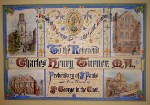 This very fine watercolour testimonial was presented to Prebendary Turner
when he left the parish (now the property of Ken McGregor of Cornwall,
and included here with his permission, for which we are grateful). As
well as the parish church, it depicts three buildings erected during
his time in the parish: the Mission House on The Highway, the
Public Library on Cable Street, and Betts Street baths and wash-houses.
This very fine watercolour testimonial was presented to Prebendary Turner
when he left the parish (now the property of Ken McGregor of Cornwall,
and included here with his permission, for which we are grateful). As
well as the parish church, it depicts three buildings erected during
his time in the parish: the Mission House on The Highway, the
Public Library on Cable Street, and Betts Street baths and wash-houses.
In the August 1923 parish magazine a former colleague wrote
| The passing away of the Bishop of Islington in
July 13th, at the ripe age of 81 years, must have recalled to many of
the older Parishioners of St. George's-in-the-East, the great work that
he did in the Parish during the years he was Rector. He was known up
and down these streets, in and out a good many homes, by young and old
alike, as a warm-hearted friend, a wise counsellor, a fine example of
quiet, Christian life. In civic affairs, as well as in matters more
directly religious, he gave a lead which left an abiding mark on the
Parish, and many a man to-day, brought up in the Day and Sunday Schools
of St. George's-in-the-East can look back gratefully to the high
purpose and strong sense of duty that marked the life of Mr. Turner, as
he he was always called. As a builder, he did great things for the Parish: the Mission Hall in St. George Street was his work especially: the Public Baths owed more to him than was generally known: the Raynes' [sic] Schools he watched and cared for with affectionate devotion: while the Parish Church, with its beauty and dignified simplicity, was fay after day and week after week his special care. Many can still remember the quiet earnestness and congregational heartiness of the Parish Church Services in his time. Every detail of the music was carefully thought out, and for years together Mr. Turner made it a rule always to be present at Choir Practice, silently sitting by, ready to advise on any matter that the Choir Master might refer to him him. He loved the young life of the place, as did Mrs. Turner with her unfailing sympathy, and the Sunday Schools in those days, with their hundreds of elder Scholars in regular attendance, were a sight of which any Parish might be proud. Dr. Turner had an exceptional power of gathering workers round him, and in getting the very best out of them. He seemed to inspire his colleagues in every department, and was able to help many a young man to face life's battle with a new sense of duty and loyalty to God. Some can still remember the 'Fathers' Meetings' held by the Rector on Thursday evenings in the Rectory. Room, when a chapter of the Bible was read and discussed, followed by lighter reading and refreshment. Few Parishes were handled with such sympathetic insight as was St. George's in those days. Wisely did the Bishop of London speak at the Memorial Service of his cheerful spirit and unfailing generosity in Church work all over London. Bishop Turner was laid to rest in the quiet churchyard of Godmanchester, the Parish of his first curacy, two of his former Curates, Bishop Joscelyne and Canon Thornon-Duesbery, taking part in the Service, and all seemed to join earnestly in the prayer then offered: Rest eternal grant him, Good Lord, and may perpetual light shine upon him in Jesus Christ our Lord. |
LECTURERS
In the second half of the century there were six further Lecturers (see here for an explanation of the post). The story of Hugh Allen (1859-60) is told here. David Brown Moore (curate 1851, then Lecturer 1854-59) and Thomas Richardson (1859-70) worked at St Matthew Pell Street, and George Davenport (1871-75) was also Vicar of the adjacent parish of St Mark Whitechapel (then separate, but now part of St George-in-the-East).
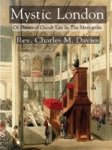 According
to R.H. Hadden, who was a curate at the time, Charles
Maurice Davies (b.1828) was
briefly Lecturer in 1875; his name certainly appears in registers. His story
is intriguing. In the 1850s,
while a fellow of Durham University and also curate of St Matthew,
City Road, he was one of the six anglo-catholic clergy who with
Charles Lowder founded the Society of the Holy Cross. But he had left
parochial ministry, apart from several brief later attachments,
to become headmaster of the West London College in 1861. After a short
spell as a Roman Catholic, he returned to the Church of England as a
liberal,
publishing novels - Philip
Paternoster: a Tractarian Love Story, by an ex-Puseyite (1858) [vol 2 online here] - partly set in a location resembling Lowder's mission houses;
Shadowland:
A Story with a Purpose (1860); Broad
Church (1875); and 'Verts (1876)
as well as translations of Sophocles and Plautus. Increasingly he was
drawn into explorations of spiritualism and psychical research,
as well as reporting on 'mainstream' churches; his journalism for the Daily Telegraph and the National Press Agency was collected into a series of widely-read books, some of which can be read
online:
According
to R.H. Hadden, who was a curate at the time, Charles
Maurice Davies (b.1828) was
briefly Lecturer in 1875; his name certainly appears in registers. His story
is intriguing. In the 1850s,
while a fellow of Durham University and also curate of St Matthew,
City Road, he was one of the six anglo-catholic clergy who with
Charles Lowder founded the Society of the Holy Cross. But he had left
parochial ministry, apart from several brief later attachments,
to become headmaster of the West London College in 1861. After a short
spell as a Roman Catholic, he returned to the Church of England as a
liberal,
publishing novels - Philip
Paternoster: a Tractarian Love Story, by an ex-Puseyite (1858) [vol 2 online here] - partly set in a location resembling Lowder's mission houses;
Shadowland:
A Story with a Purpose (1860); Broad
Church (1875); and 'Verts (1876)
as well as translations of Sophocles and Plautus. Increasingly he was
drawn into explorations of spiritualism and psychical research,
as well as reporting on 'mainstream' churches; his journalism for the Daily Telegraph and the National Press Agency was collected into a series of widely-read books, some of which can be read
online:
The
last Lecturer (described as 'Senior Curate and Evening Lecturer') was John
Sidney
Adolphus
Vatcher (1873-77), born and educated in Jersey, who
lived with his wife Marion at 62 Philpot
Street. During his time here, he attempted to mount a prosecution
against Fr Lowder of St Peter London Docks, in conjunction with the
Church Association, but the Rector Harry Jones was strongly opposed to
such a course of action and it came to nothing.
Vatcher was later vicar of St Philip Stepney, building a new church at
a cost of £40,000 (his son Sidney, 1899-1982, was born here, and served
in France in the First World War, later living in Sussex), and also
director of the
chaplaincy department of the London Hospital for 36 years until his
retirement in 1919. Samuel
and Henrietta
Barnett were friends, and visited the
Vatchers at their retirement home in Felixstowe. In
1905 he was one of nearly 2000 signatories to a petition declaring
biblical criticism to be no threat to faith. He died in 1926 aged 78, and was buried at Felixstowe.
Like his predecessor William Quekett half a century earlier, he and his wife saw colonial emigration as one solution to social problems - only now it was families and boys, rather than working girls. The East End Emigration Society and Self-Help Emigration Society (which merged in 1913 as the British Dominion Emigration Society) were among the many agencies, some of them church-based (see chapter 5 of Marjorie Kohli The Golden Bridge), which sent youths to Canada, clothed and equipped under Mrs Vatcher's leadership. The agent in Montreal described those sent by the church-based societies as a superior class of immigrants. [Later emigration programmes which sent over 150,000 children between three and fourteen to Australia and Canada between the 1920s and 1967, many through church agencies, provoked a public apology (covering wider issues) from Kevin Rudd, the Australian Premier, and a British apology may follow. Many of the children were not in fact orphans, and one motive for the programme, declared in the 1950s, was to provide migrants of 'British stock' to guard against losing the nation to the millions of Asiatics that menace us. By the end of that decade, it was claimed that British migrants were poor physical specimens, lacking in intelligence and undisciplined. There are some murky stories here.]
Like other clergy in this parish, Vatcher went to law over a family trust, in connection with his father's estate. The case, which went to the Appeal Court, turned on the doctrine of 'fraud on a power', and the duties of trustees to act within the limits of their authority. The remarks of Lord Parker in Vatcher v Paull [1915] AC 372 set the still-quoted principle of trust law that 'fraud' in this context does not necessarily denote ... any conduct ... which could be termed dishonest or immoral. It merely means that the power has been exercised for a purpose, or with an intention, beyond the scope of or not justified by the instrument creating the power.
| Here,
indeed, is one of those sudden and
surprising contrasts to be found in London. A high brick wall encloses
this oasis, and the nurses and some privileged people have keys to the
door, which opens, from a side street close to the noise of the Mile
End Road, suddenly into a peaceful, picturesque garden. The idea in the
formation was a willow-pattern plate, and the little bridge over a
miniature stream is reproduced. Plane trees in a formal array are kept
trimmed to give a dense shade, and the hammocks hung from them in
summer provide the most ideal resting-places for the worn-out nurses.
At one time animals were kept here in cages, as a kind of small "Zoo"
for Whitechapel; but since the last alterations the animals have been
relinquished, and the bear-pit makes a delightful rock garden, and the
various other cages form summer-houses. One thoughtful addition of the
vicar was placing a small stove in one of these shelters, with an array
of kettles, teapots, cups and saucers, so that any of the nurses
resting can have their al fresco cup of tea - and what could be more
grateful and comforting? |
CURATES
The second half of the 19th century was a kind of 'golden age' for curates - at least as far as parishes were concerned! In the latter years of the century, there were often three, sometimes four, on the staff - and as a consequence the Rector rarely baptized or conducted weddings. There were plenty of clergy available, and some - especially the non-Oxbridge men, and those without patronage connections - served short or longer curacies in half a dozen or more different parishes, as well as missionary stints, not because they were restless or misfits (though some of those who came here clearly were) but because they were struggling to find incumbent posts.
At some point, probably in the 1880's, 220 Cable Street (a double-fronted Georgian house) became the curates' residence, as well as housing the verger. It had briefly housed a school from 1869. The Revds Goodhart, Stafford, Taylor, Baxter, Cain, Hinscliffe and Iselin were among those who lived there.
The roll-call is as follows:
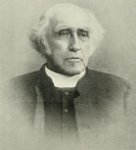 William
Charles Howell
(1862-63, left in later life), son of the Judge Advocate-General of the Forces, born 1818, took a
First in Maths at Brasenose College Oxford (in 1837 he wrote an intriguingly-entitled pamphlet Astronomical
Prayer),
and after further study at Pembroke College was ordained in 1842,
serving his title at Uxbridge. In 1850 he was curate of All Hallows
Tottenham. After his short time here, and a spell as
chaplain at Le
Havre, he became Vicar of Holy Trinity Tottenham (carved out of All
Hallows) in 1865, and remained in post there until 1904, and lived in
retirement in Regent's Park Road to the age of 96 - see this
tribute to his life's work. During his time there he saw his parish
subdivided four times, yet the population was greater when he retired
than when he arrived. He was closely involved in primary and secondary
education issues. His was also a keen amateur scientist - a member of
the British Association for the Advancement of Science, and of the
Gilbert Club, playing a key part as reviser and proofreader of their
1900 translation of Gilbert's Latin treatise of 1600 on magnetism De Magnete, working on the project with Professor Silvanus Thompson. He was also a member of the Bristol and Gloucestershire Archaeological Society, and a council member
of
the Essex Field Club, to whom he gave a paper on 'the foxglove, chiefly
etymological and local', and spoke to them on using cameras for
astronomical research:
William
Charles Howell
(1862-63, left in later life), son of the Judge Advocate-General of the Forces, born 1818, took a
First in Maths at Brasenose College Oxford (in 1837 he wrote an intriguingly-entitled pamphlet Astronomical
Prayer),
and after further study at Pembroke College was ordained in 1842,
serving his title at Uxbridge. In 1850 he was curate of All Hallows
Tottenham. After his short time here, and a spell as
chaplain at Le
Havre, he became Vicar of Holy Trinity Tottenham (carved out of All
Hallows) in 1865, and remained in post there until 1904, and lived in
retirement in Regent's Park Road to the age of 96 - see this
tribute to his life's work. During his time there he saw his parish
subdivided four times, yet the population was greater when he retired
than when he arrived. He was closely involved in primary and secondary
education issues. His was also a keen amateur scientist - a member of
the British Association for the Advancement of Science, and of the
Gilbert Club, playing a key part as reviser and proofreader of their
1900 translation of Gilbert's Latin treatise of 1600 on magnetism De Magnete, working on the project with Professor Silvanus Thompson. He was also a member of the Bristol and Gloucestershire Archaeological Society, and a council member
of
the Essex Field Club, to whom he gave a paper on 'the foxglove, chiefly
etymological and local', and spoke to them on using cameras for
astronomical research:
| The Rev. Mr. Howell had heard that small cameras could be used for some kind of stellar research. Was that so? He believed that if it were pointed to the north, the stars nearest the pole would describe circular tracks on a sensitive plate during long exposures, and that the more the camera was pointed towards the south, the more did the tracks of the stars approximate on the plate to a straight line. Last year a man taking a shot with a hand camera at the stars was said to have accidentally photographed a meteor as well. |
(Two of the clergy of the previous decade at St Paul Dock Street were keen astronomers - see here for Daniel Ace, and here for Charles Besley Gribble.)
Finally, The Wheel World of 1881 records that the Rev W.C. Howell was President of the Invincible cycling club in north London.
 Charles
Watkins Lewis (1865-68),
of St John's College Cambridge,
was ordained in 1849 and served two curacies in Peterborough diocese,
then two in his native Radnorshire (now Powys), in the second of which,
Llanbister, he was also a workhouse chaplain; after his time here and
another curacy in Hereford he returned to Llanbister as Vicar in 1868,
and was Rector of Heyope (near Knighton), also in Radnorshire, from
1886, where he was active in the Cambrian Archaeological Association;
he retired to Hereford in 1894, living in Vaga House - right - near
the cathedral (built for Mary Morris in 1961, once visited by Elgar,
now a listed building which sold for over £1m - Vaga was the Roman name
for the Wye); he died in 1912, aged 90, nine years after his wife
Harriet.
Charles
Watkins Lewis (1865-68),
of St John's College Cambridge,
was ordained in 1849 and served two curacies in Peterborough diocese,
then two in his native Radnorshire (now Powys), in the second of which,
Llanbister, he was also a workhouse chaplain; after his time here and
another curacy in Hereford he returned to Llanbister as Vicar in 1868,
and was Rector of Heyope (near Knighton), also in Radnorshire, from
1886, where he was active in the Cambrian Archaeological Association;
he retired to Hereford in 1894, living in Vaga House - right - near
the cathedral (built for Mary Morris in 1961, once visited by Elgar,
now a listed building which sold for over £1m - Vaga was the Roman name
for the Wye); he died in 1912, aged 90, nine years after his wife
Harriet.
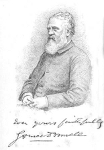 George
Alcock M'Donnell [or MacDonnell] (1866-??) was a
Dublin-born chess champion. He is sometimes confused with Alexander
McDonnell, another Irish chessman
from the
previous generation. According to Edward Winter's Chess Notes
website
[3974], Harry Golombek
described him, in the 1977 Encyclopedia of
Chess, as the strongest of all the chess-playing reverends in
Britain
in the nineteenth century. The master Steinitz, in the
International
Chess Magazine [May
1891, p147] called him the shady irreverend fou
-
this is because they had been locked in controversy over M'Donnell's
review of Wormald's book on opening gambits: he has an
unconquerable inclination to associate himself with any kind of
deception or imposition practised in the English chess press. Heady
stuff indeed!
George
Alcock M'Donnell [or MacDonnell] (1866-??) was a
Dublin-born chess champion. He is sometimes confused with Alexander
McDonnell, another Irish chessman
from the
previous generation. According to Edward Winter's Chess Notes
website
[3974], Harry Golombek
described him, in the 1977 Encyclopedia of
Chess, as the strongest of all the chess-playing reverends in
Britain
in the nineteenth century. The master Steinitz, in the
International
Chess Magazine [May
1891, p147] called him the shady irreverend fou
-
this is because they had been locked in controversy over M'Donnell's
review of Wormald's book on opening gambits: he has an
unconquerable inclination to associate himself with any kind of
deception or imposition practised in the English chess press. Heady
stuff indeed!
He was a graduate of Trinity College Dublin, ordained to a title in
that city in 1855, coming to London the following year - to St John's Wood,
St Peter Walworth, where he published four sermons Man's Life and Destiny (Bell
& Daldry 1861), then to this parish, and to St Andrew
Bethnal Green. For some years he was curate-in-charge of Old St Pancras
Church, during the vicar's long absence, but (to the disappointment of
many) was not appointed as his successor; instead, the
Duke of Rutland nominated him as incumbent of Uppingham. From 1879-96 he
wrote a weekly chess column, as 'Mars', in the Illustrated Sporting & Dramatic News. He published two books on chess, mostly of extracts from his columns - Chess Life-Pictures (Kelly 1883) and The Knights and Kings of Chess (Horace Cox 1894). Here is one of his 1883 matches. He died in 1899, after protracted illness, aged 69; here is an obituary.
[William
Henry Foy was
also Chaplain to the Union [workhouse] of St
George-in-the-East from 1868?-72 - see here for more details.]
William
James Mann (1873-5),
studied law at Queen's College Oxford (BA and 'SCL' - a pre-graduate
studentship in civil law) and was an Associate in Music of Trinity
College
London. After a short time at Berkeley Chapel, Mayfair he came here as
'Curate and Precentor', but spent most of the rest of his ministry as a
cathedral precentor, briefly at Carlisle and Winchester, then from 1882
at
Bristol, also becoming Vicar of St Thomas in that city in 1896. In 1886 he
became embroiled in the acrimonious 'Risely
controversy'. George Risely, the cathedral organist (and a gifted
orchestral
conductor) successfully appealed to the Bishop against his dismissal in
1886 - and it is said played 'Fixed in his everlasting seat' from
Handel's Samson
as the
voluntary on his first day back. Mann wrote about the importance
of a good diet for choristers' physical and musical development; and contributed these answers to two questions put to cathedral musicians, included in chapter 5 of The Boy's Voice (J. Spencer Curwen 1891).
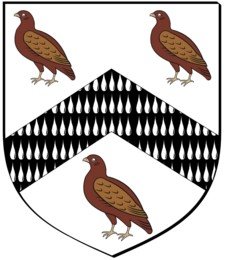 Daniel
Fleming Wilson Quayle
(1876-83) was the first of a series of
clergy
with Manx connections (Rector Jones' mother was a Quayle). Born in 1847
(baptized the following January at St Mary Castletown), he never
ministered on the Island, but family members held various offices as
magistrates and in the House of Keys (four generations, including his
father, served as Clerk of the Rolls). After Christ
Church College Oxford he was ordained in 1872, and was curate of
Bramshott in Hampshire before coming here. He worked with the East London Nursing Society: C.S. Loch of the Charity Organisation Society wrote to him for guidance about forming a similar society elsewhere. Further
briefer curacies followed at rural Brington, Holy Trinity Brompton and
Leavesden, in Hertfordshire, before he became Rector of St Martin
Trimley in Suffolk in 1892, and four years later curate in charge of
Badby with Newnham, near
Daventry, leaving in 1911 and returning to the island to live at Bridge
House, a family home in Castletown (others were at Crogga and Port
Soderic); he died in 1929. In 1883, giving Bridge House as his address, he
patented a system for window guards (one of several similar ones for
sash windows), and in 1890 a sponge holder for travellers - details here.
Daniel
Fleming Wilson Quayle
(1876-83) was the first of a series of
clergy
with Manx connections (Rector Jones' mother was a Quayle). Born in 1847
(baptized the following January at St Mary Castletown), he never
ministered on the Island, but family members held various offices as
magistrates and in the House of Keys (four generations, including his
father, served as Clerk of the Rolls). After Christ
Church College Oxford he was ordained in 1872, and was curate of
Bramshott in Hampshire before coming here. He worked with the East London Nursing Society: C.S. Loch of the Charity Organisation Society wrote to him for guidance about forming a similar society elsewhere. Further
briefer curacies followed at rural Brington, Holy Trinity Brompton and
Leavesden, in Hertfordshire, before he became Rector of St Martin
Trimley in Suffolk in 1892, and four years later curate in charge of
Badby with Newnham, near
Daventry, leaving in 1911 and returning to the island to live at Bridge
House, a family home in Castletown (others were at Crogga and Port
Soderic); he died in 1929. In 1883, giving Bridge House as his address, he
patented a system for window guards (one of several similar ones for
sash windows), and in 1890 a sponge holder for travellers - details here.
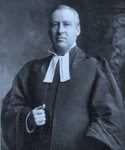 Robert
Henry Hadden
(1878-80), son of a JP and proprietor of the Liverpool Courier, studied at Merton College Oxford - he did not take his MA degree until 1900 - and was described in his early days as
a hot young ecclesiastical
reformer. Like his Rector here Harry Jones,
he served his title at St Mark North Audley Street in Mayfair, leaving
after only a year. He was a member of Stewart Headlam's Christian
Socialist Guild
of St Matthew
(created in 1877 at St Matthew Bethnal Green) and founder of
the Curates' Alliance, which campaigned, among other things,
for
selling off City churches and using the proceeds to minister to the
poor (see Harry Jones' views on this issue here). He promoted this cause (for which he had the support of John
Jackson, Bishop of London 1869-85) in the monthly journal which he
founded and owned, the Church Reformer (motto: readapting the
ecclesiastical machinery to the wants of the age).
Headlam, however, with perhaps typical perversity - he was always a
champion of lost causes - took exception to this, despite his close
friendship with Hadden: Are you,
Sir, with your support of the Bishop of London, still among the
Philistines who think that Sunday at 11 o'clock, with the women and
children in their best bonnets, is the only conceivable time for
worshipping God? Headlam's line, like that of William Morris,
was that efficiency should not be substituted for beauty, and that the
city churches should be kept open to provide rest of soul, mind, and body to over-worked and worried men and women for a few minutes each day, rather than being sold or used as show-rooms for engines. In
1884, wtih money from his father, Headlam took over the journal (which was
struggling financially), promising to make it more radical, with a definitely
Christian and catholic point of view. There will be no watering down of
the Christian Faith in our columns to make agreeable to vicious palates
... we shall try to expose all who poison it, and to counteract their
position. He replaced the paper's motto with the lines from Blake's Jerusalem - 'I will not cease from mental fight ... - for which he won John Ruskin's approval.
Robert
Henry Hadden
(1878-80), son of a JP and proprietor of the Liverpool Courier, studied at Merton College Oxford - he did not take his MA degree until 1900 - and was described in his early days as
a hot young ecclesiastical
reformer. Like his Rector here Harry Jones,
he served his title at St Mark North Audley Street in Mayfair, leaving
after only a year. He was a member of Stewart Headlam's Christian
Socialist Guild
of St Matthew
(created in 1877 at St Matthew Bethnal Green) and founder of
the Curates' Alliance, which campaigned, among other things,
for
selling off City churches and using the proceeds to minister to the
poor (see Harry Jones' views on this issue here). He promoted this cause (for which he had the support of John
Jackson, Bishop of London 1869-85) in the monthly journal which he
founded and owned, the Church Reformer (motto: readapting the
ecclesiastical machinery to the wants of the age).
Headlam, however, with perhaps typical perversity - he was always a
champion of lost causes - took exception to this, despite his close
friendship with Hadden: Are you,
Sir, with your support of the Bishop of London, still among the
Philistines who think that Sunday at 11 o'clock, with the women and
children in their best bonnets, is the only conceivable time for
worshipping God? Headlam's line, like that of William Morris,
was that efficiency should not be substituted for beauty, and that the
city churches should be kept open to provide rest of soul, mind, and body to over-worked and worried men and women for a few minutes each day, rather than being sold or used as show-rooms for engines. In
1884, wtih money from his father, Headlam took over the journal (which was
struggling financially), promising to make it more radical, with a definitely
Christian and catholic point of view. There will be no watering down of
the Christian Faith in our columns to make agreeable to vicious palates
... we shall try to expose all who poison it, and to counteract their
position. He replaced the paper's motto with the lines from Blake's Jerusalem - 'I will not cease from mental fight ... - for which he won John Ruskin's approval. 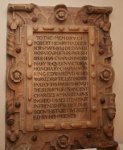 At St George's, Hadden (like his Rector Harry Jones) was a supporter of the Charity Organisation Society and served for a time on the local committee. He
went on to serve in
two then-deprived East End parishes (St
Botolph Bishopsgate and St Botolph Aldgate), before returning
to St Mark North Audley Street in Mayfair, 21 years after serving
his brief title there), and was a much-loved vicar until his early
death in 1909. He was buried at St Botolph Aldgate, with a tablet [left] in the church. In
1903 he had courted controversy by conducting the marriage of American
divorcé
William Vanderbilt and twice-widowed Anne Rutherfurd even though the
diocesan Chancellor authorised
it; see also this family account (but note that 8am, not 9am, is the earliest legal time for marriage, and Hadden's name is mis-recorded).
At St George's, Hadden (like his Rector Harry Jones) was a supporter of the Charity Organisation Society and served for a time on the local committee. He
went on to serve in
two then-deprived East End parishes (St
Botolph Bishopsgate and St Botolph Aldgate), before returning
to St Mark North Audley Street in Mayfair, 21 years after serving
his brief title there), and was a much-loved vicar until his early
death in 1909. He was buried at St Botolph Aldgate, with a tablet [left] in the church. In
1903 he had courted controversy by conducting the marriage of American
divorcé
William Vanderbilt and twice-widowed Anne Rutherfurd even though the
diocesan Chancellor authorised
it; see also this family account (but note that 8am, not 9am, is the earliest legal time for marriage, and Hadden's name is mis-recorded).
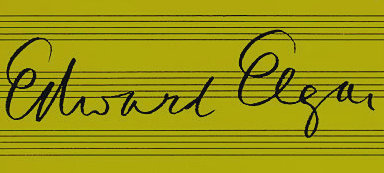
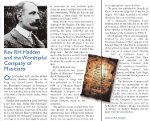 Like Harry
Jones, Hadden was a keen traveller (he had an extended trip to the USA
in 1886, sailing back to Liverpool on the City of Richmond). A member of the
Reform Club, he was made a royal
chaplain to
Victoria
and Edward VII, and acted as an editor for the Church
Times. He died suddenly, talking to a clerical friend in
Pall Mall. Elgar's Elegy for
strings
and harp (op 58), inspired by the view from Mordiford Bridge, was
dedicated to Hadden's memory, as he was Junior Warden of
the Worshipful Company of Musicians - see here from issue 30 of their journal.
Like Harry
Jones, Hadden was a keen traveller (he had an extended trip to the USA
in 1886, sailing back to Liverpool on the City of Richmond). A member of the
Reform Club, he was made a royal
chaplain to
Victoria
and Edward VII, and acted as an editor for the Church
Times. He died suddenly, talking to a clerical friend in
Pall Mall. Elgar's Elegy for
strings
and harp (op 58), inspired by the view from Mordiford Bridge, was
dedicated to Hadden's memory, as he was Junior Warden of
the Worshipful Company of Musicians - see here from issue 30 of their journal.
Willie Parkinson Jay (1878-81, when he became Vicar of Christ Church Watney Street where his story is told in more detail)
 Henry Meyners Bernard (1881-82)
studied Maths at Corpus Christi College Cambridge, and served curacies
in Wells and Herefordshire before coming here. There followed six years
as chaplain of the English Church in Moscow, which he left to study
biology and zoology under Professor Ernst Haeckel
at Jena (promoter of Darwin's work and developer of the 'recapitulation
theory'). Thereafter Bernard had a distinguished scientific career,
cataloguing the corals and fossils at the British Museum and publishing
many papers and monographs: in addition to those listed here in the Geological Magazine's obituary, he wrote The Sense of Sight: Sketch of a New Theory (1896), A Suggested Origin of the Segmented Worms, and the Problem of Metamerism (1900), Studies in the Retina (1906) and co-authored a Texbook of Comparative Anatomy (1896). Here is a letter about his theories from the naturalist Alfred R Wallace. He became a Fellow of the Linnean and Zoological Societies. He was a socialist, and wrote The Scientific Basis of Socialism: Two Essays in Evolution (New Age Press 1908). He died in London the following year, aged 55.
Henry Meyners Bernard (1881-82)
studied Maths at Corpus Christi College Cambridge, and served curacies
in Wells and Herefordshire before coming here. There followed six years
as chaplain of the English Church in Moscow, which he left to study
biology and zoology under Professor Ernst Haeckel
at Jena (promoter of Darwin's work and developer of the 'recapitulation
theory'). Thereafter Bernard had a distinguished scientific career,
cataloguing the corals and fossils at the British Museum and publishing
many papers and monographs: in addition to those listed here in the Geological Magazine's obituary, he wrote The Sense of Sight: Sketch of a New Theory (1896), A Suggested Origin of the Segmented Worms, and the Problem of Metamerism (1900), Studies in the Retina (1906) and co-authored a Texbook of Comparative Anatomy (1896). Here is a letter about his theories from the naturalist Alfred R Wallace. He became a Fellow of the Linnean and Zoological Societies. He was a socialist, and wrote The Scientific Basis of Socialism: Two Essays in Evolution (New Age Press 1908). He died in London the following year, aged 55.Walter
Lomer Barnes
(1882-84), graduate of All Souls' College Oxford, was ordained in 1874 and
served curacies at Fulham and St Saviour Fitzroy Square before coming
here (where he he lived some distance away in Tredegar Square, and was involved with the
district sub-committee of the Charity Organisation Society). After a further curacy at Walcot, Bath he became Vicar of
Alberbury
in Shropshire, and in 1894 of Barford St Martin in Salisbury
diocese, where he died in 1909. All Souls' were the patrons of both
these parishes. Here is a letter he wrote to the church paper The Guardian about clerical taxation, and a reply:
| April 7,1898. CROCKFORD'S DIRECTORY. SIR—I thank you for inserting my letter about Crockford's Clerical Directory in this week's Guardian, but I cannot say that my inquiry has received from you a satisfactory answer; indeed, you must pardon me for saying that, to my mind, the note you have appended to my letter has made confusion worse confounded. Will you allow me to state the difficulty in a concrete shape? There are two incumbents, X and Y: the income of X's benefice is derived from tithes and glebe; that of Y's benefice from funded property. X's income-tax, being charged under Schedule A, bears the name of property-tax, and ought, according to the instructions in Crockford, to be deducted when he calculates the net value of his benefice. Y's income-tax, charged under Schedule D, is called income-tax, and, according to the instructions, ought not to be deducted. What I cannot understand is on what principle the editor of Crockford justifies such a difference of procedure. In your note you seem to be of opinion that income-tax ought not to be deducted. I agree with you. But surely, on the same principle, property-tax (which is income-tax under another name) ought not to be deducted. You desoribe the instructions inserted in this year's edition of Crockford as clear; they certainly contain a clear contradiction, and no returns of net income derived from glebe, or tithes, or other real property, based on those instructions, can be considered correct until from the list of outgoings the words property-tax have been erased. W. L. BARNES. Barford St. Martin Rectory, April 7,1898. SIR—I very well remember my correspondence with the Rev. W. L. Barnes, and regret that I have been unable exfumis dare lucem, and to give him satisfaction. The note at the beginning of the Directory is the result of reference to more than one correspondent more familiar than myself with the subject, which, as you kindly say of it in your very helpful note appended to Mr. Barnes's letter that it is clear, and therefore sufficient, I shall leave with no attempt either at amendment or addition. THE EDITOR. Crockford's Clerical Directory, Bream's-buildings, E.C. |
C
W Cowley (1883-84) - also listed as curate, and member of the COS district sub-committee - more information needed
John
Robert Sinclair
Carolin (1882),
was from an extensive and 'good' - as they said in those days - Irish
clerical family. Born in Londonderry in 1856, he trained at Trinity
College Dublin and was ordained in 1879, serving at Youghal and Corkbeg
in the diocese of Cork before coming here briefly. From Youghal, in 1881 he wrote to the Church of England Pulpit & Ecclesiastical Review
on the preparation and delivery of sermons, commending the example of
Henry Clay, who as a young man in Kentucky, as he later reported to an
audience of law students, had commenced,
and continued for some years, the practice of daily reading and
speaking upon the contents of some historical or scientific book. These
off-hand efforts were made sometimes in a cornfield, at others in the
forest, and not unfrequently in some distant barn, with the horse and
the ox for my auditors. Carolin added that if those who intend to enter the Church would join a Young Men's Christian Association and speak once at every meeting,
no matter though it be only pure nonsense they can talk, I can assure
them from experience that they will become fluent speakers.
Carolin was theologically liberal. As a student, he had corresponded with the Unitarian (of Huguenot descent) Dr James Martineau,
of Manchester New College, about a 'moral case', and when Martineau
died in 1900 - insufficiently appreciated, he thought - he sent a copy
of Martineau's somewhat convoluted letter to The Spectator, which can be read here.
Also from Youghal, in the publication mentioned above, he wrote to
explain that Unitarianism and Rationalism were not the same, citing a
current case of Dr Weston of Leicester, an extreme Rationalist who had
been denied access to the local Southgate Fund for Unitarian preaching.
He was also politically a Liberal, described himself as a Christian Socialist, and was an active member of the National
Anti-Vivisection Society.
After a further curacy at the new parish of St Saviour Southwark
(Denmark Park) he became curate, and from 1886 Vicar, of St Matthew
Denmark Hill, and in 1890 the Rector of Wyvenhoe [now
Wivenhoe]
Essex, then in St Alban's diocese [originally London, transferred to
Rochester in 1846, to St Alban's in 1877, and
Chelmsford in 1914 when these latter two dioceses were created]. His
strong views and autocratic tendencies caused many conflicts in the
parish, some of which are described here,
but the musical life of the parish flourished in his time - he had the
organ fitted with hydraulic power, and restored the bells. He was a
freemason and chaplain to
the Colne Lodge, and died in 1922 of pneumonia, aged 65. His wife
Elizabeth (from county Clare) died a few years earlier - latterly
having been confined to a wheelchair; they had two daughters, and a son
R.E.G. Carolin, an army officer awarded the DSO.
Walter
Phillips
(1884-86) was a graduate of Hatfield College, Durham. After serving his
title here, he went to Queensland, where he served in Townsville,
Ingham, Warwick and Dalby, returning to England after ten years to the
diocese of York, where he was curate of Sherburn-in-Elmet, then of
Easington, then was appointed Vicar of Skirlaugh, near Hull, and
chaplain of the Skirlaugh Union [workhouse], in 1906. His son Walter
Henry Sherburn Phillips was a second lieutenant in the 4th Batallion of
the East Yorshire Regiment and was killed, aged 19, in the Battle of
the Somme; his grave ar Bazentin-le-Petit Communal Cemetery was dstroyed by shell fire and is marked with a special memorial.In 1924 his daughter Florence married Ferdinand Charles Richard Prior-Wandesforde JP DL DSO, formerly of Castlecomer House, Kilkenny.
Hugh Wilkinson
Goodhart (1885-90) – he ran the Parish Church
Youths' Institute here, before succeeding the much-loved Samuel
John Stone (who wrote The
church's one foundation and other hymns) as incumbent of
St Paul Haggerston. Stone wrote that his nerves were too worn out for
Haggerston any longer - he spent his last ten
years in the City parish of All Hallows, London Wall - and that his
successor was almost
entirely one after my own heart. There is an interview in
the Booth
Archive
B231 (pp86-103) from these years; he advertised (successfully?) for a
curate in 1899. Stone died in 1900,
and Goodhart - having led the appeal for a memorial to his predecessor
- a few months later, after a short illness, in 1901, aged 53. See here for
details
of work among Jews in that parish, led by Michael Rosenthal, later
incumbent of St Mark Whitechapel.
One of the sisters of the nearby St Saviour's Priory (the Society of St Margaret, still active there) wrote in 1903 that, although he was not in their parish, we always felt him to be,
so to speak, one of the hidden Saints of God — so kindly, so genial, so
self-sacrificing, so perfectly devoted, body and soul, to the service
of his Master. I have heard from friends in the city how very highly he
was respected and reverenced by many business men, who, as a rule, did
not care much for 'parsons'. He never rested from his zeal to help
souls; he wrote always to those whom he had prepared for Confirmation,
and who lived too far away for him to see personally, reminding them
from time to time about making their Communions. The day after his
death, a mother told me he had only the week before been asking about
herdaughter, and whether she still went to the Sunday School. 'No',
said her mother, 'she is now a teacher in St S.'s, naming another
school in a neighbouring parish. That is all as it should be', he said,
'so long as she is doing some good work for God'.
Joseph
Arthur Dodd (1886-89),
born 1860, a scholar of Corpus Christi College Oxford, served his title here, followed by a further three years at St
Botolph Aldgate (where he wrote Trouble in a City Parish under the Protectorate
(Spottiswoode 1895) about a Presbyterian predecessor). He was Rector
of Lower Heyford in Oxfordshire until 1897 (where he presided
over the inauguration of the parish council) returning to London as
Rector of South Hackney, then back to Oxfordshire in 1911 as incumbent
of
the Crown living of Ewelme (where the following year he published an
illustrated history of the church - though he was primarily a biblical
scholar). He became an accumulator
of etchings and engravings;
he died in 1922, in his will establishing Dodd's Charity for the
maintenance of St Mary Madgalen Hayton church near Brampton in Cumbria.
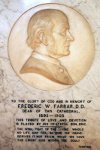
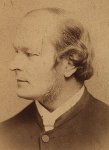 Eric
Maurice Farrar (1889-91) – another with Manx
connections. Born in Hendon in 1866, he
was the second son of Frederic
William Farrar (1831-1903) and like
him attended King William's College on the Isle of Man. His father
studied with Frederick Denison Maurice at King's College London, and
Maurice was Eric's godfather. 'Dean Farrar' was Master of Marlborough
College, Rector of St Margaret's Westminster (where Eric served
briefly as a curate), and Dean of Canterbury, and was a preacher and
prolific writer of the Broad Church movement (and also a total
abstainer - Eric stressed his temperance work in his brother Reginald's 1904 biography of their father). Dean Farrar is now best-remembered
for
his moralising stories of school life, such as Eric, or Little
by
Little. The
real-life Eric
[left] was fondly remembered in the parish for his
'noble services', and later for his 'earnest, simple addresses' as a
chaplain in the First World War (George Henderson The
experiences of a hut leader at the front 1918).
He became Vicar of Humberstone in Leicestershire and then of Rock in
Worcestershire. Sadly, Law Notes
for
1929 records that with
a
record of forty years' distinguished service as an Anglican clergyman,
[he] was found guilty at Winchester Assize Court today of
defamatory libel against Miss Dorothy Grace Sheppard, pretty
eighteen-year-old daughter of a public house proprietor at Ryde, Isle
of Wight; he admitted charges against other women and
resigned. What
had he written? He moved from Rock to become incumbent of
Ashby-by-Partney, and three years later of Salmonby near Horncastle, in
Lincoln diocese, and died in Tooting Bec Gardens in 1947 aged 81. Right is his memorial to his father, in Canterbury Cathedral.
Eric
Maurice Farrar (1889-91) – another with Manx
connections. Born in Hendon in 1866, he
was the second son of Frederic
William Farrar (1831-1903) and like
him attended King William's College on the Isle of Man. His father
studied with Frederick Denison Maurice at King's College London, and
Maurice was Eric's godfather. 'Dean Farrar' was Master of Marlborough
College, Rector of St Margaret's Westminster (where Eric served
briefly as a curate), and Dean of Canterbury, and was a preacher and
prolific writer of the Broad Church movement (and also a total
abstainer - Eric stressed his temperance work in his brother Reginald's 1904 biography of their father). Dean Farrar is now best-remembered
for
his moralising stories of school life, such as Eric, or Little
by
Little. The
real-life Eric
[left] was fondly remembered in the parish for his
'noble services', and later for his 'earnest, simple addresses' as a
chaplain in the First World War (George Henderson The
experiences of a hut leader at the front 1918).
He became Vicar of Humberstone in Leicestershire and then of Rock in
Worcestershire. Sadly, Law Notes
for
1929 records that with
a
record of forty years' distinguished service as an Anglican clergyman,
[he] was found guilty at Winchester Assize Court today of
defamatory libel against Miss Dorothy Grace Sheppard, pretty
eighteen-year-old daughter of a public house proprietor at Ryde, Isle
of Wight; he admitted charges against other women and
resigned. What
had he written? He moved from Rock to become incumbent of
Ashby-by-Partney, and three years later of Salmonby near Horncastle, in
Lincoln diocese, and died in Tooting Bec Gardens in 1947 aged 81. Right is his memorial to his father, in Canterbury Cathedral.
William
Sharpe
(1889-90), was an Associate of King's College; ordained in 1879, he
served five curacies around London (Paddington, Harmondsworth,
Hambledon, Soberton and Wandsworth) before coming here for what was
apparently his final post. He also
assisted at St John the Evangelist-in-the-East.
[Gordon
James Henry Llewellyn was
chaplain of the parish workhouse infirmary and school from 1888-94, and officiated regularly
at the parish church - more details here.]
Dr
Albert
Edward Joscelyne (1890-95),
son of Frederic (an auctioneer) and Eliza, attended Merchant
Taylors' School, winning prizes in Latin and Greek, and was a scholar
at Jesus College Oxford. He served his title here (completing his BD
degree in that time), and then for 13 years was Vicar of Millom in
Cumbria (completing his DD there); he organised the building of a
mission hall - at a cost of £1,100 - which was opened after he left. He
was an experienced mission
preacher, described as a man of moderate views, and a member of the Eighty Club
(a small club for committed members of the Liberal Party, founded in
1880). After three years as Vicar of St Peter Islington he was
appointed Bishop Coadjutor of Jamaica in 1905. In 1907 he toured the
USA appealing for funds after the major earthquake in Kingston which
had wrecked many churches, especially between Kingston and Port Maria.
(He took an interest in its geological causes, discussing with G.B. Longstaff (doctor, scientist and keen entomologist) the fault line along which contorted metamorphic strata are found, and frequent intrustions of syenite and porphyry.)
| The RIght Revd. A.E. Joscelyne, D.D., Coadjutor Bishop of Jamaica, has contributed a charming little volume in The Treasury Library of Mr. R. Scott, the London publishers. It is called The Voices of God, and contains five of his Lordship's most thoughtful and inspiring pulpit addresses. The book (which can be purchased at the Jamaica Times store; price 1/3) deals with subjects regarding which there is no division of opinion in Christendom. A Roman Catholic, a Methodist, a Presbyterian or a Baptist could read it with as much pleasure as an Anglican. And all who read it will derive profit as well as pleasure form its devout and eloquent pages. We might illustrate its tone and scope, and also the spirit in which it is written, by making a short extract from the first chapter, which is entitled The Voice of Nature. After quoting Carlyle's celebrated dictum, It is a sad and terrible thing to see men professing to be cultivated, and yet looking round in a purblind fashion, and finding no God in this universe, Bishop Joscelyne proceeds to say:One of the most hopeful signs in the world of thought today is the growing sympathy between science and religion. More and more are men of learning coming to recognise a Power behind the universe, a mighty Factor beyond anything that they themselves can know or explain. Men are coming on all hands to see the truth of Lord Kelvin's devout words: 'Science positively affirms creative power'. Such a helpful little book deserves to be widely circualted and read. |
He attended the 1908 Lambeth Conference, and spoke at the Pan-Anglican
Congress that year on the involvement of lay people in parochial
councils in Jamaica - a development still over a decade away in the
Church of England:
| DR.
JOSCELYNE, Coadjutor-Bishop of Jamaica, said that whatever else the
Church in the colonies had done, she had very largely solved the
problem of the position of the laity in the Church; and that largely by
two methods: Firstly, the colonials had made the power of the laity a
very real thing. And if the Church of England was to take the strong
place in the nation which she ought to-day, there must be no
make-believe on this matter. Parochial councils which had no authority
would never live .... Tthe
smaller unit must be commenced with, rather than the larger. The whole
position of the laity was obscured and darkened by over-heavy and
unintelligible machinery. In Jamaica the laity had representatives on three different councils. First, a Church committee, with twelve laymen, elected every January by communicants of good standing, whose names were posted in the Church. That committee was responsible for all the main elements of Church work during that year. In conjunction with the bishop of the diocese, it had the nomination of its clergy. Women were not on the council, and, so far, he thought they were wise. Then there was the Ruridecanal Council, to which every congregation in the rural deanery sent one layman, besides its clergy. The rural deanery must have the recommendation of that council before any particular requirement can be granted at head quarters. There was also a Diocesan Council, meeting monthly in the centre of the diocese, consisting of half laymen and half clergy. Unless the Church in Jamaica had had the whole of the laity behind it, it could not possibly have faced the tremendous task of rebuilding forty churches. Over all those councils was a Diocesan Synod, which sent two laymen to every clergyman in the larger churches: in the smaller ones, one layman and one clergyman. In 1870, when the Church was severed from the State, the voluntary gifts in Jamaica from the people were 300. Last year they amounted to over 17,000. |
Bishop Joscelyne
resigned his see in 1913,
settling in Salisbury diocese - where a namesake had been Bishop in the
12th century! He took on a few episcopal duties, but for six years he
was incumbent of St Mark Salisbury - a recently-formed parish,
replacing an iron church, where his first task was to complete the
nave, at a cost of £6,500; though the outbreak of war hindered the
work, it was dedicated in 1915. He then became Archdeacon
of Sherborne, combined with the post of Vicar first of Chardstock, then
from 1930-37 of Preston with Sutton
Poyntz, living after that in Weymouth; he was canon and prebendary of
Yatesbury in Salisbury cathedral from 1915. He was an active member of
the Somersetshire Archaeological and Natural History Society,
presenting to them an Australian Monitor (family Varanidæ) which he had shot himself, and later a 'third brass' coin (Urbs Roma) from the reign of Constantine I, found near Silchester. He returned
to St George-in-the-East to preach at the bicentenary
in 1929. He retired in 1941 and died in
1945, at Donhead St Mary, aged 79.
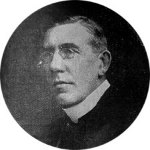 Charles
Leonard Thornton-Duesbery (1890-94) – another
Manxman (and TCD graduate), and a
layworker there before ordination. He too served in Cumbria and
Islington, and then in Essex and Marylebone, before becoming Bishop
of Sodor and Man in 1924. The Isle of Man
Examiner Annual reported
Charles
Leonard Thornton-Duesbery (1890-94) – another
Manxman (and TCD graduate), and a
layworker there before ordination. He too served in Cumbria and
Islington, and then in Essex and Marylebone, before becoming Bishop
of Sodor and Man in 1924. The Isle of Man
Examiner Annual reported
Besides being a gifted preacher, he has marked capacity for organisation; he is chairman of the Sunday School Institute, chairman of the Home Committee of the Church Missionary Society, and vice-chairman of the Church of England Temperance Society in the London diocese. He is unmistakably an Evangelical. He is well-remembered in the Isle of Man as a fine exponent of Rugby football.
He
died, aged 61, in 1928. His son Julian Percy was the staunchly
evangelical Master of St Peter's College Oxford, and Principal of
Wycliffe Hall. His daughter
Jean moved to the Isle of Man in 1939 and
became quite a power in the land; she was a Member of the House of
Keys from 1966-76.

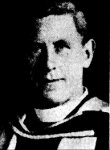
 George
Edward Alison Weeks (1892-93) [left, with and without his naval beard], born in 1868, son of George Horatio Weeks, a Rear Admiral, graduated
from Queen's College Cambridge in 1890 and served briefly in the Royal Navy, at the Torpedo School and training ship Northampton. After his short title here, and a
longer curacy at Hatcham, he served as a naval chaplain with HMS Vernon, Duke of Wellington and Victory.
He went to Natal in 1899 as Vicar of St Paul Durban, one of the churches founded under Bishop J.W. Colenso (whose liberal teachings provoked a major 'affair'
in the Anglican Communion a generation earlier) but which was in
decline. He worked hard and with success, introducing a 'moderate
Evanglical' style; his teaching was described as thorough, and his Bishop regarded him as a definite Churchman - see this article in relation to his later appointment in New Zealand. He established a
communicants' guild; he published Fettered Lives, & Other Addresses
to Men
(Sampson, Low 1903 [right]) taken from his monthly services for men (which drew
him into a vituperative spat over a document 'WIfe and Mother', which
he felt undermined the notions of chivalry and chastity), and a biography W. Spencer Walton: Approved of God to be Intrusted with the Gospel (1907). More significantly, he strove to heal some of the legal difficulties
between the church
in Natal and the Provincial Synod remaining from the Colenso affair. He also found time to complete a Durham
BD in 1901. In 1905, despite his lack of scholastic experience, he
became Principal of an independent boarding school, Hilton College in Pietermaritzburg; but the following
year (despite claiming that family reasons compelled a return to England) he advertised in The Churchman:
George
Edward Alison Weeks (1892-93) [left, with and without his naval beard], born in 1868, son of George Horatio Weeks, a Rear Admiral, graduated
from Queen's College Cambridge in 1890 and served briefly in the Royal Navy, at the Torpedo School and training ship Northampton. After his short title here, and a
longer curacy at Hatcham, he served as a naval chaplain with HMS Vernon, Duke of Wellington and Victory.
He went to Natal in 1899 as Vicar of St Paul Durban, one of the churches founded under Bishop J.W. Colenso (whose liberal teachings provoked a major 'affair'
in the Anglican Communion a generation earlier) but which was in
decline. He worked hard and with success, introducing a 'moderate
Evanglical' style; his teaching was described as thorough, and his Bishop regarded him as a definite Churchman - see this article in relation to his later appointment in New Zealand. He established a
communicants' guild; he published Fettered Lives, & Other Addresses
to Men
(Sampson, Low 1903 [right]) taken from his monthly services for men (which drew
him into a vituperative spat over a document 'WIfe and Mother', which
he felt undermined the notions of chivalry and chastity), and a biography W. Spencer Walton: Approved of God to be Intrusted with the Gospel (1907). More significantly, he strove to heal some of the legal difficulties
between the church
in Natal and the Provincial Synod remaining from the Colenso affair. He also found time to complete a Durham
BD in 1901. In 1905, despite his lack of scholastic experience, he
became Principal of an independent boarding school, Hilton College in Pietermaritzburg; but the following
year (despite claiming that family reasons compelled a return to England) he advertised in The Churchman:
| ...Relinquishing his work in Natal and seeks a charge in similar church in USA. Highly recommended by his bishop. Has had 14 years' experience in large parishes. Capable organiser and acceptable preacher. Address: Church House, Westminster. |
| The
next day, being fine, I determined to devote to an inspection of the
'stone runs', which have been rendered so famous in the geology of the
Falklands by the writings of Darwin, Wyville Thompson, and others. In
this excursion I was fortunate in having the assistance of Dr. Watts,
the colonial surgeon, a gentleman who, from his long experience of the
group, was well acquainted with all the salient points in its natural
history ... To Dr. Watts, my guide on this occasion, I was also
indebted for a skin of the Falkland Island fox, an animal now almost
extinct, a skull of the sea elephant, and a dried specimen of the
petrel, which is known here as the 'fire bird', from its habit of
dashing itself against the lantern of the lighthouse, at whose base
dead specimens are occasionally found. |
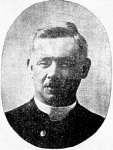
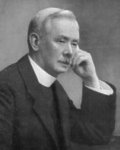 Robert
Daniel Kermode
(1893-96) [right] – a fellow-Manx curate
with
Thornton-Duesbery (though he had studied at Caius Cambridge), who
returned to the island as Vicar of Maughold, then of Lezayre; he was
rural dean of Douglas, a canon of the cathedral, and for 18 years a
Proctor in Convocation, representing the diocese at the Church
Assembly. His manuscript of the Annals of Kirk Christ Lezayre were finally published in 1954.
Robert
Daniel Kermode
(1893-96) [right] – a fellow-Manx curate
with
Thornton-Duesbery (though he had studied at Caius Cambridge), who
returned to the island as Vicar of Maughold, then of Lezayre; he was
rural dean of Douglas, a canon of the cathedral, and for 18 years a
Proctor in Convocation, representing the diocese at the Church
Assembly. His manuscript of the Annals of Kirk Christ Lezayre were finally published in 1954.
[William Romaine Thatcher was chaplain of St George's Workhouse and Infirmary and St George-in-the-East Schools at Plashet from 1894-1925 - more details here.]
Aubrey Baxter (1896-1900) had been a choral scholar at King's College Cambridge, and after St George's spent the rest of his long ministry around Chester Cathedral, where he was a Minor Canon, tutor at the Diocesan Training College (one of the Anglican teacher training colleges) from 1927-45 and much-loved Chaplain of Chester Royal Infirmary from 1926 until his retirement. For this he was awarded the MBE in 1948, and was made an honorary freeman of the city and county of Chester. The Chester Chronicle reported
| Canon Baxter is known and loved by thousands of people who have had occasion to spend any time in the Chester Royal Infirmary. There rarely passes a night when he does not tour the wards in the Infirmary with a cheery word for all the patients. He collects all the letters, and personally posts them at the Station. His physical agility and mental alertness belie his years. He confesses that he has worn out six bicycles and lost count of those he ‘borrowed’. The advantage of being the Infirmary Chaplain, Canon Baxter explained, was that the congregation was found, and there could be no excuse for not attending. “Once a patient did pretend to be asleep,” said Canon Baxter, “but I waited a bit, and his cup of tea began to get cold, so he had to wake up”. |
George Guest, later organist and choirmaster of St John's College Cambridge, had been a chorister at Chester, and in his autobiography A Guest at Cambridge (Paraclete Press 1994) recalls Canon Baxter - whose hobby was the origin of words - greeting a mother and her children in the Close with the words "Good morning, madam, do you know how we came by the word 'journeyman'? It comes from the French word, jour = day, and signifies a person who is paid by the day, rather than the week, month or year. And he went off, leaving behind one very perplexed lady."
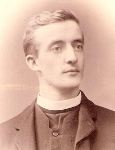 Charles
Smith Cain (1896-99) [left]
was
born in Seascale, Cumbria, educated at St Bees' School and was an
exhibitioner at The
Queen's College Oxford. After serving his title here, for 13 years he
was curate of St
Andrew Westminster (in Ashley Place, behind Westminster Cathedral, long
since
demolished), where he was involved with the London Diocesan Sunday
Schools and London School Board. He was offered an education post, but
preferred to remain in parish ministry, and went to Chelmsford diocese
as Vicar of St Barnabas Mayland from 1913-23 (serving as honorary Chaplain
to the Forces, attached to the 4th Essex Regiment, during the War) and
of Newport, near Saffron Walden, until his death in 1949, aged 76.. He was a
Hebrew
scholar; his grand-daughter Mary Saunders (who was an Oxford diocesan
officer, and has a Jewish husband) cherishes his grammar books, and a
mezuzzah
which he was presumably given at St George's. He used his sketching and
cartooning skills to illustrate his magic lantern slides. His
wife was active in the Mothers' Union, Girls' Friendly Society, Guides,
the Women's Institute and the Nursing Association. (We're grateful to
Mary for much of this information, and for this photograph, probably
taken by a local Jewish photographer.)
Charles
Smith Cain (1896-99) [left]
was
born in Seascale, Cumbria, educated at St Bees' School and was an
exhibitioner at The
Queen's College Oxford. After serving his title here, for 13 years he
was curate of St
Andrew Westminster (in Ashley Place, behind Westminster Cathedral, long
since
demolished), where he was involved with the London Diocesan Sunday
Schools and London School Board. He was offered an education post, but
preferred to remain in parish ministry, and went to Chelmsford diocese
as Vicar of St Barnabas Mayland from 1913-23 (serving as honorary Chaplain
to the Forces, attached to the 4th Essex Regiment, during the War) and
of Newport, near Saffron Walden, until his death in 1949, aged 76.. He was a
Hebrew
scholar; his grand-daughter Mary Saunders (who was an Oxford diocesan
officer, and has a Jewish husband) cherishes his grammar books, and a
mezuzzah
which he was presumably given at St George's. He used his sketching and
cartooning skills to illustrate his magic lantern slides. His
wife was active in the Mothers' Union, Girls' Friendly Society, Guides,
the Women's Institute and the Nursing Association. (We're grateful to
Mary for much of this information, and for this photograph, probably
taken by a local Jewish photographer.)
For Henry Iselin (1898-1916), see here.
<< Clergy 1729-1860 | Clergy 1900-2008 >>
Homepage
| About Us | Services & Events
| Church &
Churchyard |
History
Newsletters & Sermons | Contacts,
Links & Registers | Giving
| Picture
Gallery |
Site Map